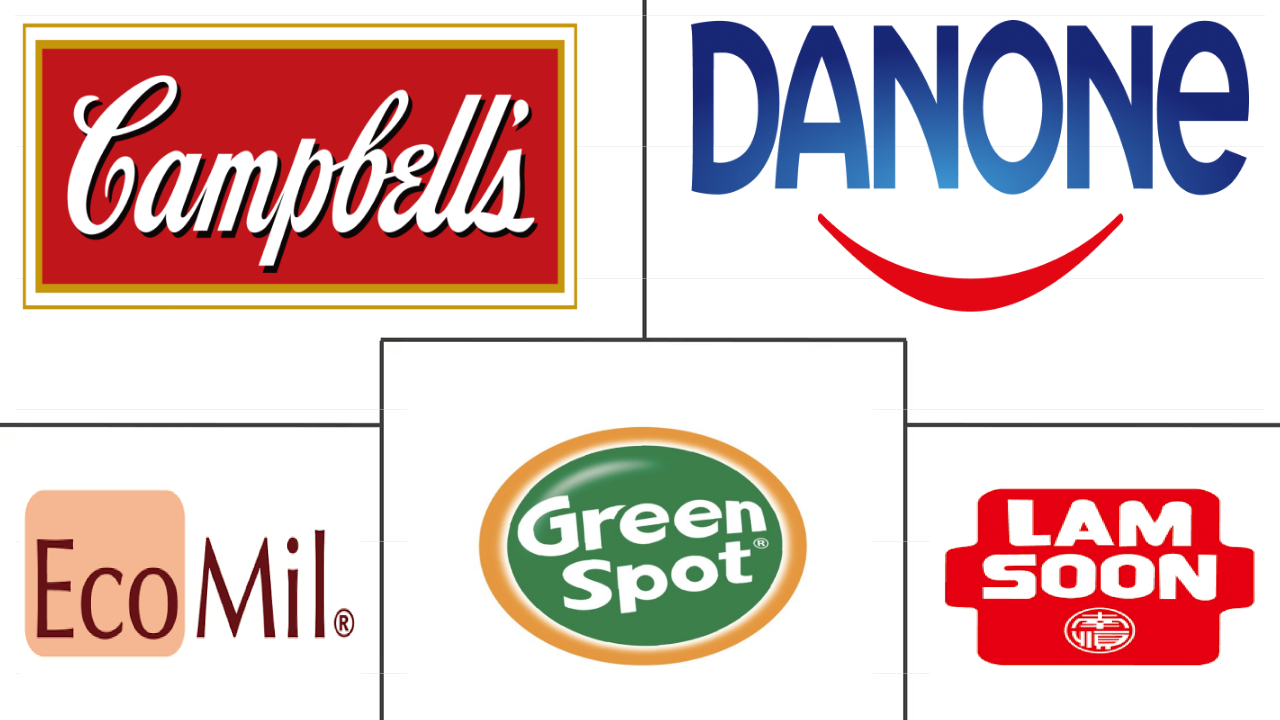Market Size of middle east dairy alternatives Industry
| Icons | Lable | Value |
|---|---|---|
|
|
Study Period | 2017 - 2029 |
|
|
Market Size (2024) | USD 347 Million |
|
|
Market Size (2029) | USD 615.2 Million |
|
|
Largest Share by Distribution Channel | Off-Trade |
|
|
CAGR (2024 - 2029) | 12.14 % |
|
|
Largest Share by Country | Saudi Arabia |
|
|
Market Concentration | Low |
Major Players |
||

|
||
|
*Disclaimer: Major Players sorted in no particular order |
Middle East Dairy Alternatives Market Analysis
The Middle East Dairy Alternatives Market size is estimated at 347 million USD in 2024, and is expected to reach 615.2 million USD by 2029, growing at a CAGR of 12.14% during the forecast period (2024-2029).
347 Million
Market Size in 2024 (USD)
615.2 Million
Market Size in 2029 (USD)
7.12 %
CAGR (2017-2023)
12.14 %
CAGR (2024-2029)
Largest Market by Category
60.92 %
value share, Non-Dairy Butter, 2023
A steady increase in consumer awareness levels about the consumption of non-dairy foods, and the impact of animal husbandry on the environment are the key factors driving the segment.
Largest Market by Country
17.20 %
value share, Saudi Arabia, 2023
Growing environmental concerns, changes in lifestyle and consumption patterns, and a growing number of allergic populations to dairy products have emerged to be major factors in Saudi Arabia.
Fastest-growing Market by Category
38 %
Projected CAGR, Non-Dairy Cheese, 2024-2029
Growing awareness regarding animal cruelty and high acceptance of veganism are prompting consumers to opt for vegan foods such as plant-based cheese, captivating to segmental growth
Fastest-growing Market by Country
11.52 %
Projected CAGR, United Arab Emirates, 2024-2029
The government’s effort to address obesity in the country with several campaigns on health awareness has translated into different lifestyle changes impacting dairy alternatives.
Leading Market Player
3.53 %
market share, Danone SA, 2022

The presence of exhaustive product offerings along with a larger distribution network and a wider presence throughout the country has made Danone S.A a leading market player.
Strong presence of supermarkets and convenience stores is boosting the dairy products sales
- In 2022, the distribution channel in the Middle East witnessed a growth of 2.69% compared to 2021. Off-trade retailing dominated the Middle Eastern retail space during the review period (2017-2022). In 2022, off-trade retailing held a share of 81.26%. In the Middle East, consumers are fascinated by off-trade retailing due to the greater convenience they get when purchasing dairy-free products.
- In on-trade channels (quick-service restaurants), the prices are fixed for non-dairy products, while consumers are given several options in off-trade channels. In the Middle East, off-trade channels offer non-dairy products at varied prices (low, medium, and high). Oat milk sold by these retailing units was available from USD 2.78 to USD 35.4 in 2022. The availability of milk at varied prices also promotes the buying power among consumers as they can purchase the products that suit their affordability parameters.
- In the Middle East, off-trade retailers focus on providing various plant-based dairy products, including different flavors such as unsweetened, chocolate, and vanilla. To increase the consumer base, they offer consumers complete information about the products, such as product specifics (ingredient used, seed used, and others). As a result, consumers purchase milk beverages through off-trade modes.
- During the forecast period, the demand for non-dairy products is expected to increase due to the rising health consciousness among the population. As a result, the dependency on retailing units is expected to observe growth during 2025-2026 by 6.25% due to higher visibility of the product to consumers.
Growing demand for plant-based products is fueling the market growth
- The rise in the vegan population concerning the rising importance of plant-based nutrition drives the demand for dairy alternatives in the region. Saudi Arabia, United Arab Emirates, and Iran exhibit significant dairy alternative consumption compared to other Middle Eastern countries. In 2022, three countries collectively held a 46.28% share of the overall dairy alternative consumption in the region.
- Saudi Arabia is the leading market for dairy alternatives in the region. Non-dairy butter and plant-based milk are majorly consumed dairy alternative products in the country. In 2022, both combinedly accounted for more than 90% of the value share. The growing lactose-intolerant population and increasing cow's milk allergy in the country have been significant factors driving the dairy alternatives market. As of 2021, 61.96% of the Saudi Arabian population had a milk allergy.
- The United Arab Emirates is the second leading market for dairy alternatives in the region. The sales value of dairy alternatives in the United Arab Emirates is anticipated to grow by USD 61.8 million in 2025, up from USD 46.8 million in 2022. The Increasing vegan population is one of the major factors for the growth of dairy alternatives in the United Arab Emirates. As of 2021, more than 8% of the United Arab Emirates population was vegan.
- High consumer awareness about plant-based nutrition and favorable macroeconomic environments are the key factors shaping the Irani dairy alternatives market. The sales of the dairy alternatives market in Iran experienced a growth rate of 20.3% from 2018 to 2022.
Middle East Dairy Alternatives Industry Segmentation
Non-Dairy Butter, Non-Dairy Cheese, Non-Dairy Ice Cream, Non-Dairy Milk, Non-Dairy Yogurt are covered as segments by Category. Off-Trade, On-Trade are covered as segments by Distribution Channel. Bahrain, Iran, Kuwait, Oman, Qatar, Saudi Arabia, United Arab Emirates are covered as segments by Country.
- In 2022, the distribution channel in the Middle East witnessed a growth of 2.69% compared to 2021. Off-trade retailing dominated the Middle Eastern retail space during the review period (2017-2022). In 2022, off-trade retailing held a share of 81.26%. In the Middle East, consumers are fascinated by off-trade retailing due to the greater convenience they get when purchasing dairy-free products.
- In on-trade channels (quick-service restaurants), the prices are fixed for non-dairy products, while consumers are given several options in off-trade channels. In the Middle East, off-trade channels offer non-dairy products at varied prices (low, medium, and high). Oat milk sold by these retailing units was available from USD 2.78 to USD 35.4 in 2022. The availability of milk at varied prices also promotes the buying power among consumers as they can purchase the products that suit their affordability parameters.
- In the Middle East, off-trade retailers focus on providing various plant-based dairy products, including different flavors such as unsweetened, chocolate, and vanilla. To increase the consumer base, they offer consumers complete information about the products, such as product specifics (ingredient used, seed used, and others). As a result, consumers purchase milk beverages through off-trade modes.
- During the forecast period, the demand for non-dairy products is expected to increase due to the rising health consciousness among the population. As a result, the dependency on retailing units is expected to observe growth during 2025-2026 by 6.25% due to higher visibility of the product to consumers.
| Category | |||||||||
| Non-Dairy Butter | |||||||||
| Non-Dairy Cheese | |||||||||
| Non-Dairy Ice Cream | |||||||||
| |||||||||
| Non-Dairy Yogurt |
| Distribution Channel | |||||||
| |||||||
| On-Trade |
| Country | |
| Bahrain | |
| Iran | |
| Kuwait | |
| Oman | |
| Qatar | |
| Saudi Arabia | |
| United Arab Emirates | |
| Rest of Middle East |
Middle East Dairy Alternatives Market Size Summary
The Middle East Dairy Alternatives Market is experiencing significant growth, driven by increasing health consciousness and a rising vegan population. Consumers in the region are increasingly turning to plant-based dairy products due to concerns over lactose intolerance and cow's milk allergies. The market is characterized by a strong preference for off-trade retailing channels, which offer a variety of non-dairy products at different price points, catering to diverse consumer preferences and budgets. This trend is further supported by the availability of various flavors and detailed product information, which enhances consumer awareness and encourages purchases. The demand for dairy alternatives is particularly strong in countries like Saudi Arabia, the United Arab Emirates, and Iran, where the consumption of plant-based milk and non-dairy butter is on the rise.
The market landscape is fragmented, with a few key players holding a small share, indicating opportunities for growth and competition. Major companies such as Campbell Soup Company, Danone SA, Ecomil, Green Spot Co. Ltd, and Lam Soon Group are actively participating in the market, introducing new products and expanding their offerings. The introduction of locally produced products, like oat milk in Saudi Arabia, and acquisitions of health-focused brands highlight the dynamic nature of the market. Despite the growth in certain product categories, others like yogurt, cheese, and ice cream remain underdeveloped. Overall, the Middle East Dairy Alternatives Market is poised for continued expansion, driven by changing consumer preferences and increasing awareness of plant-based nutrition.
Middle East Dairy Alternatives Market Size - Table of Contents
-
1. MARKET SEGMENTATION (includes market size in Value in USD and Volume, Forecasts up to 2029 and analysis of growth prospects)
-
1.1 Category
-
1.1.1 Non-Dairy Butter
-
1.1.2 Non-Dairy Cheese
-
1.1.3 Non-Dairy Ice Cream
-
1.1.4 Non-Dairy Milk
-
1.1.4.1 By Product Type
-
1.1.4.1.1 Almond Milk
-
1.1.4.1.2 Cashew Milk
-
1.1.4.1.3 Coconut Milk
-
1.1.4.1.4 Oat Milk
-
1.1.4.1.5 Soy Milk
-
-
-
1.1.5 Non-Dairy Yogurt
-
-
1.2 Distribution Channel
-
1.2.1 Off-Trade
-
1.2.1.1 Convenience Stores
-
1.2.1.2 Online Retail
-
1.2.1.3 Specialist Retailers
-
1.2.1.4 Supermarkets and Hypermarkets
-
1.2.1.5 Others (Warehouse clubs, gas stations, etc.)
-
-
1.2.2 On-Trade
-
-
1.3 Country
-
1.3.1 Bahrain
-
1.3.2 Iran
-
1.3.3 Kuwait
-
1.3.4 Oman
-
1.3.5 Qatar
-
1.3.6 Saudi Arabia
-
1.3.7 United Arab Emirates
-
1.3.8 Rest of Middle East
-
-
Middle East Dairy Alternatives Market Size FAQs
How big is the Middle East Dairy Alternatives Market?
The Middle East Dairy Alternatives Market size is expected to reach USD 346.96 million in 2024 and grow at a CAGR of 12.14% to reach USD 615.23 million by 2029.
What is the current Middle East Dairy Alternatives Market size?
In 2024, the Middle East Dairy Alternatives Market size is expected to reach USD 346.96 million.

